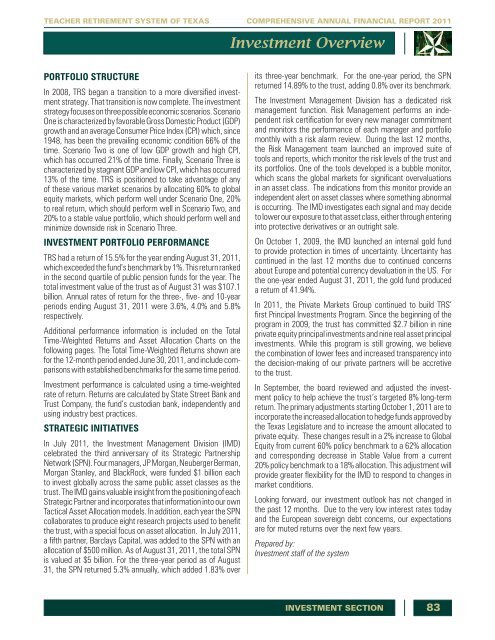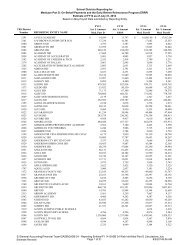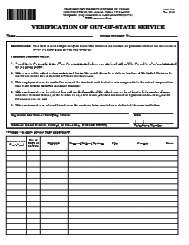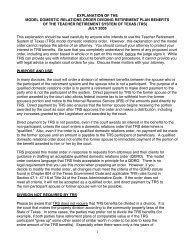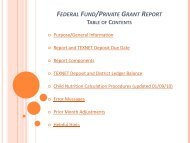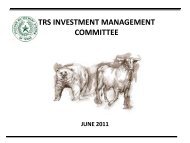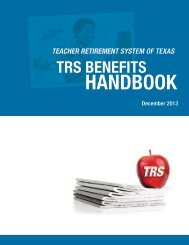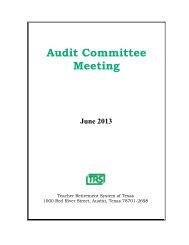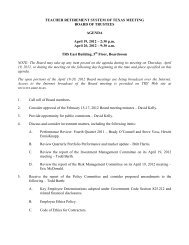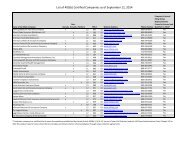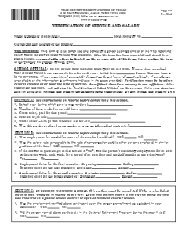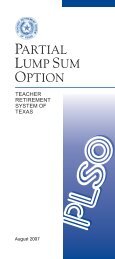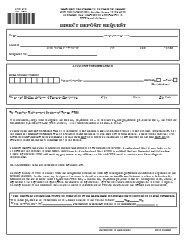TRS 2011 Comprehensive Annual Financial Report
TRS 2011 Comprehensive Annual Financial Report
TRS 2011 Comprehensive Annual Financial Report
You also want an ePaper? Increase the reach of your titles
YUMPU automatically turns print PDFs into web optimized ePapers that Google loves.
TEACHER RETIREMENT SYSTEM OF TEXAS COMPREHENSIVE ANNUAL FINANCIAL REPORT <strong>2011</strong><br />
Investment Overview<br />
PORTFOLIO STRUCTURE<br />
In 2008, <strong>TRS</strong> began a transition to a more diversified investment<br />
strategy. That transition is now complete. The investment<br />
strategy focuses on three possible economic scenarios. Scenario<br />
One is characterized by favorable Gross Domestic Product (GDP)<br />
growth and an average Consumer Price Index (CPI) which, since<br />
1948, has been the prevailing economic condition 66% of the<br />
time. Scenario Two is one of low GDP growth and high CPI,<br />
which has occurred 21% of the time. Finally, Scenario Three is<br />
characterized by stagnant GDP and low CPI, which has occurred<br />
13% of the time. <strong>TRS</strong> is positioned to take advantage of any<br />
of these various market scenarios by allocating 60% to global<br />
equity markets, which perform well under Scenario One, 20%<br />
to real return, which should perform well in Scenario Two, and<br />
20% to a stable value portfolio, which should perform well and<br />
minimize downside risk in Scenario Three.<br />
INVESTMENT PORTFOLIO PERFORMANCE<br />
<strong>TRS</strong> had a return of 15.5% for the year ending August 31, <strong>2011</strong>,<br />
which exceeded the fund’s benchmark by 1%. This return ranked<br />
in the second quartile of public pension funds for the year. The<br />
total investment value of the trust as of August 31 was $107.1<br />
billion. <strong>Annual</strong> rates of return for the three-, five- and 10-year<br />
periods ending August 31, <strong>2011</strong> were 3.6%, 4.0% and 5.8%<br />
respectively.<br />
Additional performance information is included on the Total<br />
Time-Weighted Returns and Asset Allocation Charts on the<br />
following pages. The Total Time-Weighted Returns shown are<br />
for the 12-month period ended June 30, <strong>2011</strong>, and include comparisons<br />
with established benchmarks for the same time period.<br />
Investment performance is calculated using a time-weighted<br />
rate of return. Returns are calculated by State Street Bank and<br />
Trust Company, the fund’s custodian bank, independently and<br />
using industry best practices.<br />
STRATEGIC INITIATIVES<br />
In July <strong>2011</strong>, the Investment Management Division (IMD)<br />
celebrated the third anniversary of its Strategic Partnership<br />
Network (SPN). Four managers, JP Morgan, Neuberger Berman,<br />
Morgan Stanley, and BlackRock, were funded $1 billion each<br />
to invest globally across the same public asset classes as the<br />
trust. The IMD gains valuable insight from the positioning of each<br />
Strategic Partner and incorporates that information into our own<br />
Tactical Asset Allocation models. In addition, each year the SPN<br />
collaborates to produce eight research projects used to benefit<br />
the trust, with a special focus on asset allocation. In July <strong>2011</strong>,<br />
a fifth partner, Barclays Capital, was added to the SPN with an<br />
allocation of $500 million. As of August 31, <strong>2011</strong>, the total SPN<br />
is valued at $5 billion. For the three-year period as of August<br />
31, the SPN returned 5.3% annually, which added 1.83% over<br />
its three-year benchmark. For the one-year period, the SPN<br />
returned 14.89% to the trust, adding 0.8% over its benchmark.<br />
The Investment Management Division has a dedicated risk<br />
management function. Risk Management performs an independent<br />
risk certification for every new manager commitment<br />
and monitors the performance of each manager and portfolio<br />
monthly with a risk alarm review. During the last 12 months,<br />
the Risk Management team launched an improved suite of<br />
tools and reports, which monitor the risk levels of the trust and<br />
its portfolios. One of the tools developed is a bubble monitor,<br />
which scans the global markets for significant overvaluations<br />
in an asset class. The indications from this monitor provide an<br />
independent alert on asset classes where something abnormal<br />
is occurring. The IMD investigates each signal and may decide<br />
to lower our exposure to that asset class, either through entering<br />
into protective derivatives or an outright sale.<br />
On October 1, 2009, the IMD launched an internal gold fund<br />
to provide protection in times of uncertainty. Uncertainty has<br />
continued in the last 12 months due to continued concerns<br />
about Europe and potential currency devaluation in the US. For<br />
the one-year ended August 31, <strong>2011</strong>, the gold fund produced<br />
a return of 41.94%.<br />
In <strong>2011</strong>, the Private Markets Group continued to build <strong>TRS</strong>’<br />
first Principal Investments Program. Since the beginning of the<br />
program in 2009, the trust has committed $2.7 billion in nine<br />
private equity principal investments and nine real asset principal<br />
investments. While this program is still growing, we believe<br />
the combination of lower fees and increased transparency into<br />
the decision-making of our private partners will be accretive<br />
to the trust.<br />
In September, the board reviewed and adjusted the investment<br />
policy to help achieve the trust’s targeted 8% long-term<br />
return. The primary adjustments starting October 1, <strong>2011</strong> are to<br />
incorporate the increased allocation to hedge funds approved by<br />
the Texas Legislature and to increase the amount allocated to<br />
private equity. These changes result in a 2% increase to Global<br />
Equity from current 60% policy benchmark to a 62% allocation<br />
and corresponding decrease in Stable Value from a current<br />
20% policy benchmark to a 18% allocation. This adjustment will<br />
provide greater flexibility for the IMD to respond to changes in<br />
market conditions.<br />
Looking forward, our investment outlook has not changed in<br />
the past 12 months. Due to the very low interest rates today<br />
and the European sovereign debt concerns, our expectations<br />
are for muted returns over the next few years.<br />
Prepared by:<br />
Investment staff of the system<br />
INVESTMENT SECTION<br />
83


